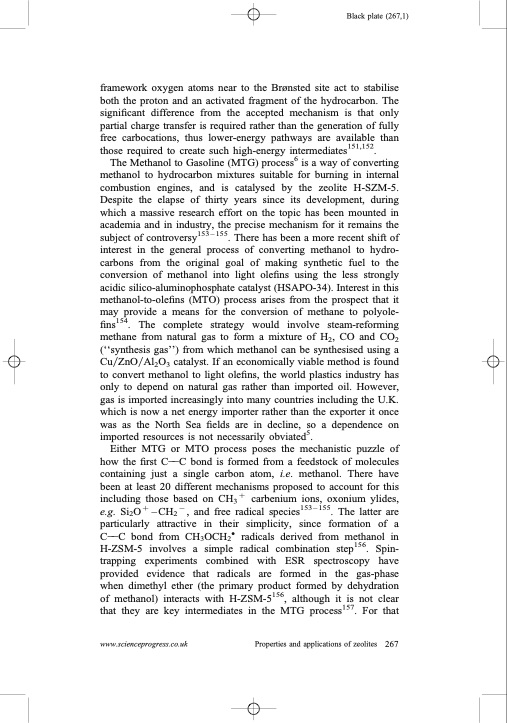
PDF Publication Title:
Text from PDF Page: 045
Black plate (267,1) framework oxygen atoms near to the Brønsted site act to stabilise both the proton and an activated fragment of the hydrocarbon. The significant difference from the accepted mechanism is that only partial charge transfer is required rather than the generation of fully free carbocations, thus lower-energy pathways are available than those required to create such high-energy intermediates151,152. The Methanol to Gasoline (MTG) process6 is a way of converting methanol to hydrocarbon mixtures suitable for burning in internal combustion engines, and is catalysed by the zeolite H-SZM-5. Despite the elapse of thirty years since its development, during which a massive research effort on the topic has been mounted in academia and in industry, the precise mechanism for it remains the subject of controversy153 – 155. There has been a more recent shift of interest in the general process of converting methanol to hydro- carbons from the original goal of making synthetic fuel to the conversion of methanol into light olefins using the less strongly acidic silico-aluminophosphate catalyst (HSAPO-34). Interest in this methanol-to-olefins (MTO) process arises from the prospect that it may provide a means for the conversion of methane to polyole- fins154. The complete strategy would involve steam-reforming methane from natural gas to form a mixture of H2, CO and CO2 (‘‘synthesis gas’’) from which methanol can be synthesised using a CuyZnOyAl2O3 catalyst. If an economically viable method is found to convert methanol to light olefins, the world plastics industry has only to depend on natural gas rather than imported oil. However, gas is imported increasingly into many countries including the U.K. which is now a net energy importer rather than the exporter it once was as the North Sea fields are in decline, so a dependence on imported resources is not necessarily obviated5. Either MTG or MTO process poses the mechanistic puzzle of how the first C2C bond is formed from a feedstock of molecules containing just a single carbon atom, i.e. methanol. There have been at least 20 different mechanisms proposed to account for this including those based on CH3 þ carbenium ions, oxonium ylides, e.g. Si2Oþ –CH2, and free radical species153–155. The latter are particularly attractive in their simplicity, since formation of a C2C bond from CH3OCH2 radicals derived from methanol in H-ZSM-5 involves a simple radical combination step156. Spin- trapping experiments combined with ESR spectroscopy have provided evidence that radicals are formed in the gas-phase when dimethyl ether (the primary product formed by dehydration of methanol) interacts with H-ZSM-5156, although it is not clear that they are key intermediates in the MTG process157. For that www.scienceprogress.co.uk Properties and applications of zeolites 267PDF Image | Properties and applications of zeolites

PDF Search Title:
Properties and applications of zeolitesOriginal File Name Searched:
003685010x12800828155007.pdfDIY PDF Search: Google It | Yahoo | Bing
CO2 Organic Rankine Cycle Experimenter Platform The supercritical CO2 phase change system is both a heat pump and organic rankine cycle which can be used for those purposes and as a supercritical extractor for advanced subcritical and supercritical extraction technology. Uses include producing nanoparticles, precious metal CO2 extraction, lithium battery recycling, and other applications... More Info
Heat Pumps CO2 ORC Heat Pump System Platform More Info
| CONTACT TEL: 608-238-6001 Email: greg@infinityturbine.com | RSS | AMP |